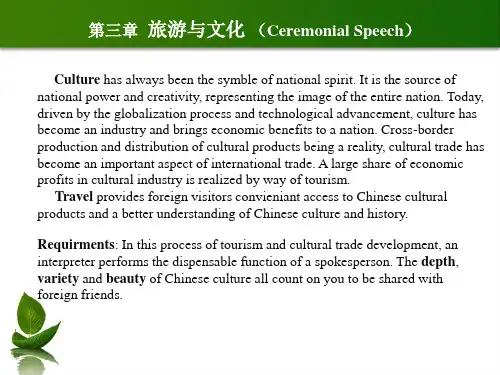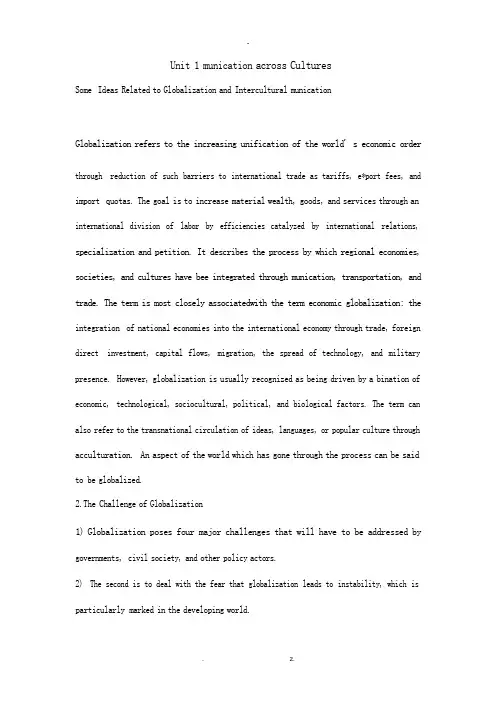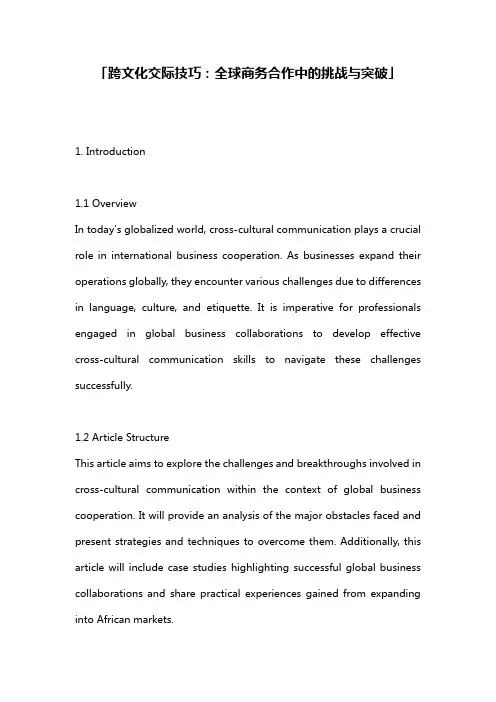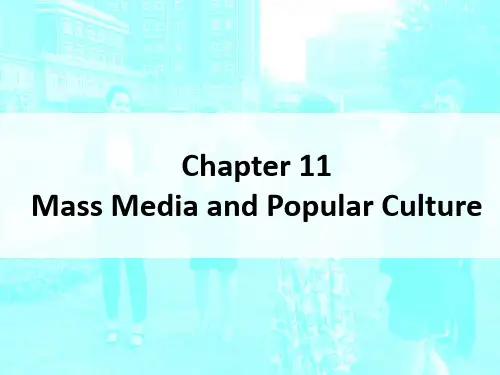跨文化商务交际-unit 11Barriers to Intercultural Communication
- 格式:ppt
- 大小:399.00 KB
- 文档页数:12




Unit1munication across CulturesSome Ideas Related to Globalization and Intercultural municationGlobalization refers to the increasing unification of the world’s economic order through reduction of such barriers to international trade as tariffs,e*port fees,and import quotas.The goal is to increase material wealth,goods,and services through an international division of labor by efficiencies catalyzed by international relations, specialization and petition. It describes the process by which regional economies, societies, and cultures have bee integrated through munication, transportation, and trade. The term is most closely associatedwith the term economic globalization: the integration of national economies into the international economy through trade,foreign direct investment,capital flows,migration,the spread of technology,and military presence.However,globalization is usually recognized as being driven by a bination of economic,technological,sociocultural,political,and biological factors.The term can also refer to the transnational circulation of ideas,languages,or popular culture through acculturation.An aspect of the world which has gone through the process can be said to be globalized.2.The Challenge of Globalization1) Globalization poses four major challenges that will have to be addressed by governments,civil society,and other policy actors.2)The second is to deal with the fear that globalization leads to instability,which is particularly marked in the developing world.3)The third challenge is to address the very real fear in the industrial world that increased global petition will lead ine*orably to a race to the bottom in wages,labor rights,employment practices,and the environment.4)And finally,globalization and all of the plicated problems related to it must not be used as e*cuses to avoid searching for new ways to cooperate in the overall interest of countries and people.Several implications for civil society,for governments and for multinational institutions stem from the challenges of globalization.1) New technology, in the form of transportation and munication systems, has accelerated intercultural contact.Trips once taking days,weeks,or even months are now measured in hours. Supersonic transports now make it possible for tourists, business e*ecutives,or government officials to enjoy breakfast in San Francisco and dinner in Paris—all on the same day.2) Innovative munication systems have also encouraged and facilitated cultural interaction.munication satellites,sophisticated television transmission equipment,and digital switching networks now allow people throughout the world to share information and ideas instantaneously.Whether via the Internet,the World Wide Web,or a N news broadcast,electronic devices have increased cultural contact.3)Globalization of the economy has further brought people together.This e*pansion in globalization has resulted in multinational corporations participating in various international business arrangements such as joint ventures and licensing agreements. These and countless other economic ties mean that it would not be unusual forsomeone to work for an organization that does business in many countries.4) Changes in immigration patterns have also contributed to the development of e*panded intercultural contact.Within the boundaries of the United States,people are now redefining and rethinking the meaning of the word American.Neither the word nor the reality can any longer be used to describe a somewhat homogeneous group of people sharing a European heritage.4.Si*Blocks in Intercultural municationAssumption of similaritiesOne answer to the question of why misunderstanding and/or rejection occurs is that many people naively assume there are sufficient similarities among peoples of the world to make munication easy. They e*pect that simply being human and having mon requirements of food,shelter,security,and so on makes everyone alike.Unfortunately, they overlook the fact that the forms of adaptation to these mon biological and social needs and the values,beliefs,and attitudes surrounding them are vastly different from culture to culture.The biological monalties are not much help when it es to munication, where we need to e*change ideas and information,find ways to live and work together, or just make the kind of impression we want to make.Language differencesThe second stumbling block —language difference —will surprise no one. Vocabulary,synta*,idioms,slang,dialects,and so on all cause difficulty,but the person struggling with a different language is at least aware of being in trouble.A greater language problem is the tenacity with which some people will cling tojust one meaning of a word or phrase in the new language,regardless of connotation or conte*t.The variations in possible meaning,especially when inflection and tone are varied,are so difficult to cope with that they are oftenwaved aside.This placency will stop a search for understanding. Even “yes” and “no” cause trouble. There are other language problems,including the different styles of using language such as direct, indirect;e*pansive,succinct;argumentative,conciliatory;instrumental,harmonizing; and so on. These different styles can lead to wrong interpretations of intent and evaluations of insincerity,aggressiveness,deviousness,or arrogance,among others. Nonverbal misinterpretationsLearning the language,which most visitors to foreign countries consider their only barrier to understanding,is actually only the beginning.To enter into a culture is to be able to hear its special“hum and buzz of implication.”This suggests the third stumbling block,nonverbal misinterpretations.People from different cultures inhabit different sensory realities.They see,hear,feel,and smell only that which has some meaning or importance for them.They abstract whatever fits into their personal worldof recognition and then interpret it through the frame of reference of their own culture. The misinterpretation of observable nonverbal signs and symbols—such as gestures, postures, and other body movements —is a definite munication barrier. But it is possible to learn the meanings of these observable messages,usually in informal rather than formal ways.It is more difficult to understand the less obvious unspoken codes of the other cultures,such as the handling of time and spatial relationships and the subtle signs of respect of formality.Preconceptions and stereotypesThe fourth stumbling block is the presence of preconceptions and stereotypes. If the label “inscrutable” has preceded the Japanese guests, their behaviors (including the constant and seemingly inappropriate smile) will probably be seen as such. The stereotype that Arabs are “inflammable” may cause U.S. students to keep their distance or even alert authorities when an animated and noisy group from the Middle East gathers. A professor who e*pects everyone from Indonesia, Me*ico, and many other countries to“bargain”may unfairly interpret a hesitation or request from an international student as a move to get preferential treatment.Stereotypes are over-generalized, secondhand beliefs that provide conceptual bases from which we make sense out of what goes on around us, whether or not they are accurate or fit the circumstances.In a foreign land their use increases our feelingof security.But stereotypes are stumbling blocks for municators because they interfere with objective viewing of other people.They are not easy to overe in ourselves or to correct in others,even with the presentation of evidence.Stereotypes persist because they are firmly established as myths or truisms by one’s own culture and because they sometimesrationalize prejudices.They are also sustained and fed by the tendency to perceive selectively only those pieces of new information that correspond to the images we hold.Tendency to evaluateThe fifth stumbling block to understanding between persons of differing cultures is the tendency to evaluate,to approve or disapprove,the statements and actions of theother person or group. Rather than try to prehend thoughts and feelings from the worldview of the other,we assume our own culture or way of life is the most natural. This bias prevents the open-mindedness needed to e*amine attitudes and behaviors from the other’s point of view.The mismunication caused by immediate evaluation is heightened when feelings and emotions are deeply involved;yet this is just the time when listening with understanding is most needed.The admonition to resist the tendency to immediately evaluate does not mean that one should not develop one’s own sense of right and wrong.The goal is to look and listen empathetically rather than through the thick screen of value judgments that impede a fair and total understanding.Once prehension is plete,it can be determined whether or not there is a clash in values or ideology.If so,some form of adjustment or conflict resolution can be put into place.High an*ietyHigh an*iety or tension, also known as stress, is mon in Cross-cultural e*periences due to the number of uncertainties present. The two words, an*iety and tension, are linked because one cannot be mentally an*ious without also being physically tense. Moderate tension and positive attitudes prepare one to meet challenges with energy. Too much an*iety or tension requires some form of relief, which too often es in the form of defenses, such as the skewing of perceptions, withdrawal,or hostility.That’s why it is considered a serious stumbling block.An*ious feelings usually permeate both parties in an intercultural dialogue.The hostnational is unfortable when talking with a foreigner because he or she cannot maintain the normal flow of verbal and nonverbal interaction.There are language and perception barriers;silences are too long or too short;and some other norms may be violated.He or she is also threatened by the other’s unknown knowledge, e*perience and evaluation.Reading IIntercultural munication:An Introductionprehension questions1.Is it still often the case that“everyone‟s quick to blame the alien”in theThis is still powerful in today‘s social and political rhetoric.For instance,it is not unmon intoday‘s society to hear people say that most,if not all,of the social and economic problems arecaused by minorities and immigrants.2.What‟s the difference between today‟s intercultural contact and that of any time inToday‘s intercultural encounters are far more numerous and of greater importance than in anytime in history.New technology,in the form of transportation and munication systems,has acceleratedintercultural contact;innovative munication systems have encouraged and facilitated culturalinteraction;globalization of the economy has brought people together; changes in immigration patterns have also contributed to intercultural encounter.4.How do you understand the sentence“culture is everything and everywhere”Culture supplies us with the answers to questions about what the world looks like and how welive and municate within that world.Culture teaches us how to behave in our life from theinstant of birth.It is omnipresent.The three major socio-cultural elements that directly influence perception and municationare cultural values,worldview(religion),and social organizations(family and state).6. What does one‟The family teaches the child what the world looks like and his or her place in that world.Because language is not only a form of preserving culture but also a means of sharing nguage is an organized,generally agreed-upon,learned symbol system thatis used to representthe e*periences within a cultural munity.People can attach meaning to nonverbal behaviors such as gestures,postures,faciale*pressions,eye contact and gaze,touch,etc.A free,culturally diverse society can e*ist only if diversity is permitted to flourish withoutprejudice and discrimination,both of which harm all members of the society. Reading IIThe Challenge of Globalizationprehension questionsMany things,such as political changes and technological advances,have changed the worldvery rapidly.In the past most human beings were born,lived,and died within a limited geographicalarea,never encountering people of other cultural backgrounds. Such an e*istence,however,nolonger prevails in the world.Thus,all people are faced with the challenge of understanding thischanged and still fast changing world in which we live.2.What a“global village”As our world shrinks and its inhabitants bee interdependent,people from remote culturesincreasingly e into contact on a daily basis.In a global village,members of once isolatedgroups of people have to municate with members of other cultural groups. Those people maylive thousands of miles away or right ne*t door to each other.Technology,particularly telemunications and puters are considered to be the majordriving force.4.What does the author mean by saying that“the…global‟may be more local than the … local‟”The increasing global mobility of people and the impact of new electronic media on humanmunications make the world seem smaller. We may municate more with people of othercountries than with our neighbors,and we may be more informed of the international events than ofthe local events.In this sense,“the‘global’may be more local than the‘local’”Effective munication may be the most important petitive advantage that firms have tomeet diverse customer needs on a global basis.Succeeding in the global market today requires theability to municate sensitively with people from other cultures,a sensitivity that is based on anunderstanding of cross-cultural differences.6.What are the serious problems that countries throughout the world are confrontedCountries throughout the world are confronted with serious problems such as volatileinternational economy,shrinking resources,mounting environmental contamination, and epidemicsthat know no boundaries.This case shows that in a world of international interdependence,the ability to understand andmunicate effectively with people from other cultures takes on e*treme urgency.If we areunaware of the significant role culture plays in munication,we may place the blame formunication failure on people of other cultures.Globalization,for better or for worse,has changed the world greatly.Whether we like it or not,globalization is all but unstoppable.It is already here to stay.It is both a fact and an opportunity.Thechallenges are not insurmountable.Solutions e*ist,and are waiting to be identified and implemented.From a globalistic point of view,there is hope and faith in humanity.Case StudyCase 1In this case,there seemed to be problems in municating with people of different cultures inspite of the efforts made to achieve understanding.We should know that in Egypt as in many cultures,the human relationship is valued so highlythat it is note*pressed in an objective and impersonal way.While Americans certainly value humanrelationships,they are more likely to speak of them in less personal,more objective terms.In thiscase,Richard‘s mistake might be that he chose to praise the food itself rather than the total evening,for which the food was simply the setting ore*cuse.For his host and hostess it was as if he hadattended an art e*hibit and plimented the artist by saying,What beautiful frames your picturesare in.In Japan the situation may be more plicated.Japanese people value order and harmonyamong persons in a group,and that the organization itself-be it a family or a vast corporation-ismore valued than the characteristics of any particular member.In contrast,Americans stressindividuality as a value and are apt to assert individual differences when they seem justifiably inconflict with the goals or values of the group. In this case:Richard‘s mistake was in making greatefforts to defend himself.Let the others assume that the errors were not intentional,but it is not rightto defend yourself, even when your unstated intent is to assist the group by warning others of similarmistakes.A simple apology and acceptance of the blame would have been appropriate.But for poorRichard to have merely apologized would have seemed to him to be subservient,unmanly.When it es to England,we e*pect fewer problems between Americans and Englishmenthan between Americans and almost any other group.In this case we mightlook beyond the gestureof taking sugar or cream to the values e*pressed in this gesture: for Americans,―H elp yourself;forthe English counterpart,―B e my guest.American and English people equally enjoy entertaining andbeing entertained but they differ somewhat in the value of the distinction.Typically,the ideal guestat an American party is one who―m akes himself at home,even to the point of answering the dooror fi*ing his own drink.For persons in many other societies,including at least this hypotheticalEnglish host,such guest behavior is presumptuous or rude.Case 2A mon cultural misunderstanding in classes involves conflicts between what is said to bedirect munication style and indirect munication style.In American culture,people tend tosay what is on their minds and to mean what they say.Therefore,students in class are e*pected toask questions when they need clarification.Me*ican culture shares this preference of style withAmerican culture in some situations,and that‘s why the students from Me*ico readily adopted thetechniques of asking questions in class.However,Korean people generally prefer indirectmunication style,and therefore they tend to not say what is on their minds and to rely more onimplications and inference,so as to be polite and respectful and avoid losing face through anyimproper verbal behavior.As is mentioned in the case,to many Koreans,numerous questions wouldshow a disrespect for the teacher,and would also reflect that the student has not studied hard enough.Case 3The conflict here is a difference in cultural values and beliefs.In the beginning,Mary didn‘trealize that her Dominican sister saw her as a member of the family,literally.In the Dominican view,family possessions are shared by everyone of the family.Luz was acting as most Dominican sisterswould do in borrowing without asking every time. Once Mary understood that there was a differentway of looking at this,she would bee more accepting.However,she might still e*perience thesame frustration when this happened again.She had to find ways to cope with her own emotionalcultural reaction as well as her practical problem(the batteries running out). Case 4It might be simply a question of different rhythms.Americans have one rhythm in their personaland family relations,in their friendliness and their charities.People from other cultures havedifferent rhythms.The American rhythm is fast.It is characterized by a rapid acceptance of others.However,it is seldom that Americans engage themselves entirely in a friendship.Their friendshipsare warm,but casual,and specialized.Fore*ample,you have a neighbor who drops by in themorning for coffee.You see her frequently,but you never invite her for dinner---not because youdon‘t think she could handle a fork and a knife,but because you have seen her that morning.Therefore,you reserve your more formal invitation to dinner for someone wholives in a moredistant part of the city and whom you would not see unless you e*tended an invitation for a specialoccasion.Now,if the first friend moves away and the second one moves nearby,you are likely toreverse this---see the second friend in the mornings for informal coffee meetings,and the first oneyou will invite more formally to dinner.Americans are,in other words,guided very often by their own convenience.They tend to makefriends easily,and they don‘t feel it necessary to go to a great amount of trouble to see friends oftenwhen it bees inconvenient to do so,and usually no one is hurt.But in similar circumstancespeople from many other cultures would be hurt very deeply.. z.。




名词对应。
(Kinesics):the nonverbal behavior related to the movement of the body or part of the body.(身势):非言语行为相关的运动身体肌肤上或局部的身体。
(etiquette):it refers to manners and behavior considered acceptable in social and business situations.(礼仪): 它指的是礼貌和行为认为是可以接受的,在社会和商业管理硕士学位。
(pragmatics):it is the study of how speakers use the language to reach successful communication, and the study of the effect that language has on human perceptions and behaviors.(语用学): 它是研究如何说话者可以运用语言达到成功的交际,而且该研究结果的语言对人类的观念和行为。
(power distance):the degree to which power differences are expected and accepted by society.(权力距离): 在何种程度上的力量和接受不同是被期望的社会。
(Values): a learned organization of rules for marking choices and for resolving conflicts.(价值观): 学会组织的规则为标志的选择和解决冲突。
(reverse culture shock):it refers to the “shock” one experiences upon returning to one’s home culture after growing used to a new one.(反向文化冲击): 它指的是“震惊”一经使用后返回到一个新的增长一对一的家居文化体验。

「跨文化交际技巧:全球商务合作中的挑战与突破」1. Introduction1.1 OverviewIn today's globalized world, cross-cultural communication plays a crucial role in international business cooperation. As businesses expand their operations globally, they encounter various challenges due to differences in language, culture, and etiquette. It is imperative for professionals engaged in global business collaborations to develop effective cross-cultural communication skills to navigate these challenges successfully.1.2 Article StructureThis article aims to explore the challenges and breakthroughs involved in cross-cultural communication within the context of global business cooperation. It will provide an analysis of the major obstacles faced and present strategies and techniques to overcome them. Additionally, this article will include case studies highlighting successful global business collaborations and share practical experiences gained from expanding into African markets.1.3 PurposeThe purpose of this article is twofold: firstly, to raise awareness about the importance of cross-cultural communication skills in global business collaboration; secondly, to equip readers with practical tips and insights on how to effectively communicate and build relationships with individuals from different cultural backgrounds. By understanding and applying these techniques, professionals can enhance their ability to succeed in the global marketplace.Overall, by addressing the challenges and potential solutions related to cross-cultural communication in international business cooperation, this article aims to contribute towards fostering more productive and harmonious relationships between individuals from diverse cultural backgrounds.2. 跨文化交际挑战2.1 语言障碍跨文化交际中的语言障碍是一项常见挑战。


跨文化重点总结Chapter1P4MNC: A firm having operations in more than one country, international sales, and a nationality mix among managers and owners.P17Global Economic Systems1.Market EconomyA market economy exists when private enterprise reserves theright to own property and monitor the production and distribution of goods and services while the state simply supports competition and efficient practices.mand EconomyA commend economy is comparable to a monopoly in the sensethat the organization in this case the government, has explicit control over the price and the supply of a good or service.3.A mixed economy is a combination of a market and a commandeconomy.(While some sectors of this system reflect private ownership and the freedom and flexibility of the law of demand , other sectors are subject to government planning.)Chapter2P36International jurisdiction: a jurisdictional principle of international law which holds that every country has jurisdiction over its citizen no matter where they are located.Doctrine of Comity: a jurisdictional principle of international law which holds that there must be mutual respect for the laws, institutions, and governments of other countries in the matter of jurisdiction over their own citizens.Chapter3P55Ethics: the study of morality and standards of conducts.P58Figure 3-1P62CSR: corporate social responsibility. The actions of a firm to benefit society beyond the requirements of the law and the direct interests of the firm.NGOs: nongovernmental organizations. Private, not-for profit organizations that seek to serve society’s interests by focusing on social, political, and economic issues such as poverty, social justice, education, health, and the environment.P64Table 3-1: Principles of the Global CompactChapter4P100Culture: acquired knowledge that people use to interpret experience and generate social behavior. This acknowledge forms values creates attitudes, and influence behavior.The six features of culture1.Learned. Culture is not inherited or biologically based; it isacquired by learning and experience.2.Shared. People as members of a group, organization, or societyshare culture; it is not specific to single individuals.3.Transgenerational. Culture is cumulative, passed down from onegeneration to the next.4.Symbolic. Culture is based on the human capacity to symbolizeor use one thing to represent another.5.Patterned. Culture has structure and is integrated; a change in onepart will bring changes in another.6.Adaptive. Culture is based on human capacity to change or adapt,as opposed to the more genetically driven adaptive process of animals.P101Table4-1 Priorities of Culture Values: United States, Japan, and Arab CountriesUnited States Japan Arab Countries1.Freedom 1. Belonging 1.Family security2.Independence 2. Group harmony 2.Family Harmony3.Self-reliance 3. Collectiveness 3.Parental guidance4.Equality 4. Age/Seniority 4.Age5.Individualism 5. Group consensus 5.Authoritypetition 6. Cooperation promise7.Efficiency 7. Quality 7.Devotion8.Time 8. Patience 8.patience9.Directness 9. Indirectness 9.Indirectness10.Openness 10. Go-between 10.HospitalityP1028 specific examples1.Centralized vs. decentralized2.Safety vs. risk3.Individual vs. group rewardsrmal vs. formal procedures5.High vs. low organizational loyalty6.Cooperation vs. competition7.Short-term vs. long-term horizons8.Stability vs. innovationP105Values: basic convictions that people have recording what is right or wrong, good or bad, important and unimportant.P108Hofstede’s Culture DimensionsBackground: for one company——IBM1.Power distanceThe extent to which less powerful members of institutions and organizations accept that power is distributed unequally.2.Uncertainty AvoidanceThe extent to which people feel threatened by ambiguous situations and have created beliefs and institutions that try toavoid these.3.Individualism & CollectivismIndividualism: the tendency of people to look after themselves and their immediate family only.Collectivism: the tendency of people to belong to groups or collectives and to look after each other in exchange for loyalty.4.Masculinity & FemininityMasculinity: a cultural characteristic in which the dominant values in society are success, money, and things.Femininity: a cultural characteristic in which the dominant values in society are caring for others and the quality of life.P114Trompenaars’s Cultural DimensionsBackground: 15000 managers from 28 countries1.Universalism vs. ParticularismUniversalism: the belief that ideas and practices can be applied everywhere in the world without modification.Particularism: the belief that circumstances dictate how ideas and practices should be applied and that something cannot be done the same everywhere.2.Individualism vs. CommunitarianismCommunitarianism: refers to people regarding themselvesas part of a group.3.Neutral vs. EmotionalNeutral culture: a culture in which emotions are held incheck.Emotional culture: a culture in which emotions areexpressed openly and naturally.4.Specific vs. DiffuseSpecific culture: a culture in which individuals have a largepublic space they readily share with others and a smallprivate space they guard closely and share with only closefriends and associates.Diffuse culture: a culture in which public space and privatespace are similar in size and individuals guard their publicspace carefully, because entry into public space affordsentry into private space as well.5.Achievement vs. AscriptionAchievement culture: a culture in which people areaccorded status based on how well they perform theirfunctions.Ascription culture: a culture in which status is attributedbased on who or what a person is.P116Figure 4-8Trompenaars’s Relationship Orientations on Cultural Dimensions 1.Universalism ParticularismUSA, Aus, Ger/Swi, Swe, UK, NL, Czh, Ita, Bel, Brz, Fra, Jap/Sin, Arg, Mex, Tha, HK, Chi, Ido, CIS, Ven2.IndividualismCommunitarianismUSA, Czh, Arg/CIS/Mex, UK, Swe/Aus, Spa/NL, Brz, Swi, Bel, Ven, HK, Ita, Ger, Chi, Fra, Ido, Jpn, Tha, Sin3.Neutral EmotionalJpn, UK, Sin, Aus, Ido, HK, Tha, Bel/Ger, Swe/Arg/USA, Czh/Fra, Spa, Ita/Ven, CIS, Brz, Chi, Swi, NL, Mex4.Specific DiffuseAus, UK, USA/Swi, Fra, NL, Bel, Brz, Czh, Ita/Ger, Arg/Jpn/Mex, Ido, CIS, Tha, HK/Sin/Swe, Spa, Chi, Ven5.Achievement AscriptionAus, USA, Swi/UK, Swe/Mex, Ger, Arg, Tha, Bel, Fra, Ita/Brz, NL/HK, Spa, Jpn, Czh, Sin, CIS, Chi, Ido, VenP119Time: Sequential SynchronousSequential: approaches are prevalent, people tend to do only one activity at a time, keep appointments strictly, and show a strong preference for following plans as they are laid out and not deviatingfrom them.Synchronous: approaches are common, people tend to do more than one activity at a time, appointments are approximate and may be changed at a moment’s notice, and schedules generally are subordinate to relationship.P122GLOBAL: a multicountry study and evaluation of cultural attributes and leadership behaviors among more than 17000 managers from 951 organizations in 62 countries.P123GLOBAL 9 dimensions1.Uncertaintyavoidance2.Power distance3.Collectivism I: 社会集体主义4.Collectivism II: 组内集体主义5.Gender egalitarianism6.Assertiveness7.Future orientation8.Performance orientation9.Humane orientationChapter 5P1344 predispositions1.Ethnocentric predisposition: a nationalistic philosophy ofmanagement whereby the values and interests of the parent company guide strategic decisions2.Polycentric predisposition: a philosophy of management wherebystrategic decisions are tailored to suit the cultures of the countries where the MNC operates.3.Regiocentricpredisposition: a philosophy of managementwhereby the firm tries to blend its own interests with those of its subsidiaries on a regional basis.4.Geocentric predisposition: a philosophy of management wherebythe company tries to integrate a global systems approach to decision making.Globalization imperative: a belief that one worldwide approach to doing business is the key to both efficiency and effectiveness.P1381.Parochialism: the tendency to view the world through one’s owneyes and perspectives.2.Simplification: the process of exhibiting the same orientationtoward different cultural groups.P141HAIRL:Helicopter: the capacity to take a broad view from above; Analysis: the ability to evaluate situations logically and completely; Imagination: the ability to be creative and think outside the box; Reality: the ability to use information realistically;Leadership: the ability to effectively galvanize and inspire personnel.Chapter 6P161Organizational culture: shared values and beliefs that enable members to understand their roles in and the norms of the organization.1.Observed behavioral regularities, as typified by commonlanguage, terminology, and rituals.员工行为规范2.Norms.3.Dominant values.4.Philosophy.5.Rules.anizational climate.P164Table 6-1: Dimensions of Corporate CultureMotivationRelationshipIdentifyCommunicationControlConductP167EquityFulfillment-oriented Project-orientedCulture CulturePerson INCUBATOR GUIDED MISSLE Task Emphasis FAMILY EIFFEL TOWER EmphasisPower-oriented Role-oriented Culture CultureHierarchyFamily culture: a culture that is characterized by a strong emphasis on hierarchy and orientation to the person.Effiel Tower culture: a culture that is characterized by strong emphasis on hierarchy orientation to the task.Guided missile culture: a culture that is characterized by strong emphasis on equality in the workplace and orientation to the task. Incubator culture: a culture that is characterized by strong emphasis on equality in the workplace and orientation to the person.P174Figure 6-4: locations of international Cross-Culture Interaction1.Domestic firms 无2.International firms 出口3.Multinational firms 外商直接投资4.Global firms 全球化图下面那一段话~P175Group multiculturalism1.Homogeneous groups2.Taken groups3.Bicultural groups4.Multicultural groups缺点:1.Overall, diversity may cause a lack of cohesion that results in theunit’s inability to take concert action, be productive, and a work environment that is conductive to both efficiency and effectiveness.2.Another potential problem may be perceptual.3.Still another potential problem with diversity groups ismiscommunication or inaccurate communication which can occur for a number of reasons.4.Another contribution to miscommunication may be the way inwhich situations are interpreted.5.Diversity also may lead to communication problems because ofdifferent perceptions of time.优点1.While there are some potential problems to overcome when usingculturally diverse groups in today’s MNCs, there are also very many benefits to be gained. In particular, there is growing evidence that culturally diverse groups can enhance creativity, lead to better decisions, and result in more effective and productive performance.2.One main benefit of diversity is the generation of more and betterideas. Because group members come from a variety of cultures, they often are able to create a greater number of unique(and thuscreative) solutions and recommendations.3.A second major benefit is that culturally diverse groups canprevent groupthink, which is caused by social conformity and pressures on individual members of a group to conform and reach consensus.4.Diversity in the workplace enhances more than the internaloperations but relationships to customers as well. Groupthink: consensus reached because of social conformity and pressures on individual members of a group to conform to group norms.P178Figure 6-5: Group Effectiveness and CultureHighly Average Highly Ineffectiveness effectiveness effectivenessChapter 7P187Context: information that surrounds a communication and helps convey the message.In high-context societies, such as Japan and many Arab countries, messages are often highly coded and implicit.In low-context societies, such as the United States and Canada, message is explicit and the speaker says precisely what he or she means.In high-context cultures, messages are implicit and indirect. One reason is that those who are communicating—family, friends, co-workers, client——tend to have both close personal relationships and large information networks.In low-context cultures, people often meet only to accomplish objectives. They do not know each other very well, they tend to be direct and focused in their communication.By finding out what types of questions are typically asked when someone is contacted and told to attend a meeting.High-context/implicit Japanese Communication Arabs Culture Latin AmericansItaliansEnglishFrenchNorth AmericansScandinaviansGermans Low-context/implicitSwiss Germans CommunicationCultureP189Elaborate to Succinct SuccessIn high-context societies, the elaborate style is often very common. The exacting style is more common in nations such as England, Germany, and Sweden.The exacting style is most common in Asia.The exacting style is more common in low-context, low-uncertainty-avoidance cultures.P201Nonverbal communication: the transfer of meaning through meanssuch as body language and the use of physical space.1.Kinesicsa.Oculesicsb.Posturec.Gestures——haptics2.Proxemicsa.Intimate distance: distance between people that is used forvery confidential communicationb.Personal distance: in communicating, the physical distanceused for talking with family or close friends.c.Social distance: in communicating, the distance used to handlemost business transactions.d.Public distance: in communicating, the distance used whencalling across the room or giving a talk to a group.3.Chronemicsa.Monochromic time scheduleb.Polychromic time schedule4.ChromaticsP203Figure 7-3: Personal Space Categories for Those in the United States1.Intimate distance: 18’’2.Personal distance: 18’’ to 4’3.Social distance: 4’ to 8’4.Public distance: 8’ to 10’P204Achieving Communication Effectiveness1.Improve Feedback Systems2.Provide Language Training3.Provide Culture Training4.Increase Flexibility and Cooperation自己总结下细点~P207Managing Cross-Culture NegotiationsNegotiation: bargaining with one or more parties for the purpose of arriving at a solution acceptable to all.1.Distributive negotiations: bargaining that occurs when two partieswith opposing goals compete over a set value.2.Integrative negotiation: bargaining that involves cooperationbetween two groups to integrate interests, create values, and invest in the agreement.P208The negotiation process1.Planning2.Interpersonal Relationship Building3.Exchanging Task-Related Information4.Persuasion5.Agreement自己总结下细点~学委们记得的几个重点:Hofstede文化维度Tropminarrs文化维度文化的定义的六个特点的意思(国际管辖权)(P174 Figure 6.4)(P161 Organizational culture)(P204 Achieving communication effectiveness)。